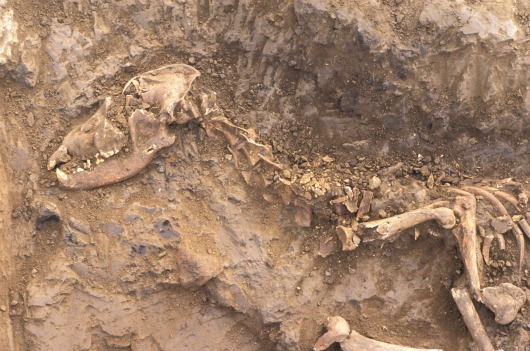
The Department of Anthropology’s Alan Leventhal is exploring “the interrelationship between the genus Canis and hunter-gatherers through a case study of prehistoric Native Americans in the San Francisco Bay-Sacramento Delta area.” (photo courtesy of Alan Leventhal)
The Department of Anthropology’s Alan Leventhal and colleagues delve into this question in an article recently published by the Journal of Archeological Science (Volume 40, Issue 4).
The piece “explores the interrelationship between the genus Canis and hunter-gatherers through a case study of prehistoric Native Americans in the San Francisco Bay-Sacramento Delta area. A distinctive aspect of the region’s prehistoric record is the interment of canids.”
“This is the first application of using ancient DNA in California in order to segregate out whether these large canids were domesticated dogs, coyotes or wolves,” Leventhal said.
Leventhal talked to SJSU Today about his work. The following was edited for length and clarity:
SJSU: What do you teach?
Leventhal: I teach ANTHRO 195/280, which is an advanced practicum archeology lab class analyzing and excavating sites in the Bay Area with the local Ohlone tribe.
SJSU: Can you tell us about your research with dogs of Central California?
Leventhal: It’s principally focused on the identification of canid burials that were found in Central California. Sometimes, when we do measurements on the animal remains, some of them are so large that they look like they fall into the wolf category. Our group applied the use of ancient DNA in order to test the validity of these animal burials, which then also helps in terms of the interpretation of the symbolic placement of the human burials in the human cemeteries.
SJSU: How many people were in your group?
Leventhal: There were seven coauthors, some out of UC Davis and some with the Far Western Anthropological Research Group.
SJSU: What was your role?
Leventhal: Back in the 1990s, we excavated a site from the Kaphan Umux (“Three Wolves”) tribe that had 102 human burials and animal burials, which we thought because of their size, were wolves. When the human remains were reburied the tribe decided not to rebury the wolves for future research. Years later, my colleagues at UC Davis, who had a hard time locating previously published canid burials going back to the 1940s, wanted to know if the wolves were still available and I said yes. My effort was to contribute particular bone samples from a 1960 SJSU excavation of a mortuary mound by Coyote Hills in the East Bay and contact the photographers of the animal burials themselves.
SJSU: What interests you most about your research?
Leventhal: My research is on several levels. One is connecting the descendents of the San Francisco Bay Ohlones to their 10,000-year-old history, then training them to do their own archeology and working collaboratively with our students and the tribe. Another level is my students, who are authoring and coauthoring archeological reports from various sites in the Bay Area and all the way to Santa Cruz. I enjoy laying out a database of understanding the history of human adaption and the evolution of complex Native American societies that lived here.
SJSU: What are you working on now?
Leventhal: We are now working on an exhibit up at Oakland Museum on one of the largest mortuary mounds in Emeryville and interpreting the placement of validity in these towns.

